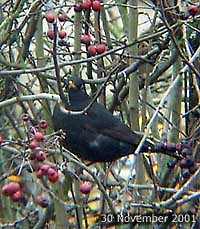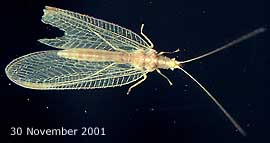Go to latest entry.....................................Go to previous entry
6 November - Since my last entry I have spent a week in Cornwall. The weather was amazing, with mild, sunny days and some excellent sunsets over the sea (When we are there in the Summer the sun sets over land). This time last year we had rain every day there, but this time the rain only fell for a short time, late one evening.
Under the shelter of the Burberris bush the first leaves of next Spring's Lesser Cellandine plants have made an appearance in the last week (This year they started flowering on 14 March). I shall have to look again to see if there are any other Spring plants showing first signs above the ground.
A female Blackbird was seen feeding down on the ground by the Burberris. A Jay spent some time in the Hawthorn in the morning and there were several visits by a Coal Tit to the feeder. Also seen were several Blue Tits and at least one Great Tit. There was a Robin about all day and a couple of Collared Doves spent time on the ground here.
The flowers are in fact an inflorescence with a single female and several male flowers. The inflorescence is surounded by four modified leaves (bracts) that give the impression of being green petals. To take the right hand photograph of a 'flower' I cut away a couple of leaves and a milky sap oozed out. This liquid contains a poison called euphorbone.
During the morning we had a pair of Jays come into the garden (A first time I have seen this). One spent time in the Hawthorn tree yesterday - they are becoming regulars. In addition to the sparrow flock, A Great Tit and a number of Blue Tits came to the feeder thoughout the day. There are Chaffinches about, although I have not seen them feeding down in the garden recently. The female Sparrowhawk paid a visit this afternoon but again left empty-handed. I have not seen the Coal Tits today. There seem to be at least 6 Blue tits around at the moment. I have a camera monitoring the birdbox and so far there has been no sign of any of these birds using it for roosting. Before I forget, yesterday I spent about five minutes watching a pair of Goldcrests hunting their way around my neighbour's Birch tree.
9 November - No pictures today but a couple of things to record. There was no repeat of yesterday's wintery blast but it has remained cold all day. The bird-bath was iced over for the first time this morning. I was out for several hours in the day but while I was here I saw feeding visits by a Goldfinch, Wood Pigeon, Great Tit, Dunnock and Coal Tit (in addition to the 'usuals'). 14 November - In the last couple of days things have been very quiet. It has remained quite cold and last night the bird bath froze over for the second time. As I write this at 10am the Hawthorn is alive with restless sparrows that are enjoying the bright sunshine of a cloudless morning. So far, the only other birds to appear in the garden this morning have been a few Blue Tits, a pair of Great Tits and a Goldfinch (up in the conifers). ! have not noticed any new larger fungi appearing in the garden of late. However close inspection of the leaves left on the Birch tree has come up with a couple of very small types.
The white areas seem to be a mat of white filaments. Scattered over this mat are small spherical fruiting bodies (0.25-0.3mm diameter)which range from white to black in colour. The black bodies have straight filaments radiating out from them. The base of each filament seems to be swollen, or surounded by a drop of liquid (?- there has been no sign of this evaporating after the leaf has been in a warm room). Click on the image for a larger version. Delving into an old botany textbook I came up with a clue as to what these structures may be. In a chapter on Mildews and moulds. It showed a diagram of a perithecium - a spherical reproductive structure formed by a mass of hyphae which aggregate into a tiny ball, anything from 0.05-0.3mm in diameter. The filaments that radiate out from it are single-celled out-growths that have different shapes in different genera. A set of comparative diagrams narrows the one in the photograph to Phyllactinia. Species of this genus cause a powdery mildew in various trees, including Birch - it may well be Phyllactinia guttata! Here is one website that includes a couple of photographs of the Genus - If you select this link it will open in a new window which may hide this one! The site uses the word cleistothecia (rather than perithecia) which seems to be a more specific term for the spheres. http://www.cals.ncsu.edu/course/pp318/profiles/pm/Phyllactinia.html Bird activity has been generally low although there have been a few things to note. On Monday I saw a Song Thrush spend a bit of time at the bottom of the garden. Yesterday, we had a visit by some 30+ Starlings, something that used to be a regular occurence. A male Blackbird spent the best part of an hour perched in the heart of the Hawthorn, although I did not see it go down to the ground to feed - perhaps we will gain a replacement for the pair we lost at the end of the Summer. I mentioned a Wood Pigeon in my last diary entry and on Tuesday we had three here. One of them spent time in the Hawthorn picking off haws and eating them -the first time I have seen them doing this. Unfortunately as I moved to take a photograph it flew off.
18 November - This weekend I had to head for the roof-top to deal with a damaged TV antenna. It has given me a rare chance to get a 'bird's eye' view of the garden and the neighbourhood. The right-hand picture is looking North towards the top of our road (and the top of the hill). The trees beyond the houses mark the position of the Brickfields Country Park - a wildlife sanctuary hemmed in by the spread of housing developments. As the pictures show, there
is still a fair amount of green left amongst the Autumnal colours
as the weather continues to stay relatively mild for most of
the time. Although I did not spend too much time looking at details, the roof provides a very different environment to the rest of the garden below. The gritty, concrete tiles provide a good surface for lichen, while the junctions between them are favoured by the mosses. I think the lichen shown here may be Xanthoria parietina which favours places where there is nitrogen enrichment by bird droppings. I have to go back up tomorrow. Perhaps I will have time to take a closer look at what else might grow up there.
This is a ridge tile, well populated with a mixture of mosses and lichens. Below the ridge the population density drops quickly, so that by half way down the surface looks more like the picture above. The level of moss growth is controlled by bird activity. When there are Starlings about we often need to sweep away the moss bombs that come tumbling down from the roof! On the bit of roof accessible from my roof ladder, there seem to be two sorts of lichen, the Xanthoria (above) and this one, which I think may be Lecanora muralis, which is common on nutrient-rich roofs,rocks etc. The largest growths I could see were about 15-16cm across.
There seem to be several types of moss up there. This one forms small, well rounded structures, the one shown is about 4-5cm. I think is is Grimmia pulvinata, common on walls, roofs rocks and mortar. It has a large number of fruit capsules. While most of these are 'old' there are some new, green capsules - my reference book states that these are produced in the Spring. Has the moss been fooled by the weather? Click on the image for a large picture. I will add some more moss pictures tomorrow. Over the last two days the garden has had visits by Long-tailed Tits, a Goldfinch and, this morning I spent five minutes watching a Goldcrest working its way through the branches of a small Scots Pine (Christmas Tree) growing in a pot just outside the dining room. Yesterday I saw a Cormorant fly over, the second in a week.
Similar in size and construction, the cups measure about 6cm across and 3.5cm deep, and they are about 5-6 cm high(external measurement). Constructed out of twigs, they have a small amount of grass, feathers and moss as a nest cup lining.
Here are some pictures of another moss growing on the roof. It grows into tightly packed, dome shapes like the one shown, which measures about 12x8x4cm. Unlike the one pictured yesterday, there are few spore capsules present, standing about 1cm above the surface. There are a number of new(?) growths which are pictured at the right. I guess that these may be developing spore capsules. This moss seems to be pretty common on the rooftops around here, but I cannot come up with an ID for it yet. Click on the image to see a larger version. Just one bird note for the day. Walking back up the garden for a break from the pruning I had a close encounter with a Sparrowhawk that was crossing the garden at about my nose level - its wing clipped me as it passed with a 'whooshing' sound. I should also note that the Coal Tit is now a regular visitor to the feeder. 22 November - I was away from home most of today, but something worth noting is that this morning both male and female Blackbirds came to the Hawthorn to eat some haws. They are spending a lot of time in the garden now. With a bit of luck they are becoming replacements for the pair we lost earlier in the year. There are pairs of Great Tits and Chaffinches about more frequently at the moment. I should have said yesterday about the biggest flock of Starlings down in the garden for a long time, perhaps 20+. We have had a lot more, but not in the last couple of years. The Cormorant went over again. 23 November - This week the leaf fall on the Hawthorn and the Birch is almost complete and I can now see through both trees. The opening to the Blue Tit box is now visible from the house. At 10.30am I have just seen a Wren in the garden for the first time since April. It spent time hunting in the plants just out side the window. A Wood Pigeon has been sampling haws again. It finds it quite a challenge as the outer branches of the Hawthorn bow down under its weight so that it can snatch only one or two before losing its balance and 'falling' out of the tree. This afternoon I spotted a Goldcrest in the Leylandii, and the Sparrowhawk paid another visit - unsuccessful (I think).
This morning we have had visits from a Dunnock, a Greenfinch and a couple of Goldfinches. The Sparrowhawk has made another half-hearted attack on the Sparrows, spending some time looking down on the garden from the conifers before leaving. Yesterday I spent some time watching the Blackbird female tearing apart the nest that was built in the Hawthorn by our previous Blackbirds. Was she just looking for food, or did the action have some other purpose? Talking of nests, Greenfinches are the most likely candidates for builders of the nests I found in the Leylandii last week. Another look at the nests revealed that fine roots were used in the linings (I originally took them to be just dried grass).
In the morning sunshine I was able to spend some time watching a Goldcrest and a Coal Tit feeding amongst the conifers. I saw the Goldcrest fly out several times to try to catch insects flying near the trees. Having seen the Blackbird's
destruction of the old nest yesterday, I checked the nest that
was built in the Berberris. That has met the same fate in the
last couple of days. It has been suggested that she may be be
destroying what is another female's old nest
A first look in a field guide suggests that it is an aptly named Winter Moth (Operophtera brumata). if it is, then it is a male as the females are virtually wingless. Their caterpillars are 'loopers', similar to one I photographed on 27 August. The adults begin to emerge after the frosts begin, from mid-October to the end of December. The females run up trees or shrubs and after mating their eggs are laid on buds, hatching out when the buds burst in April/May.
30 November - November is coming to a gloomy, damp and mild end. At 10.30am this morning the temperature is up to 13C. Bird activity has been very limited so far. However, the Blackbird pair have spent a long time perched in the Hawthorn, eating haws and giving me this chance to picture the male. This image shows a white patch on the bird's left side. His right side does not have any marks that I can see. Earlier, when we had 5 Collared Doves about, there was a bit of agressive displaying going on between them. And before I forget, It looks like the Buttercup will see its way into December, although the second bud shows no sign of opening.
One last image to squeeze into this month. This rather battered lacewing is resting on the window just to my right as I type this at 10pm - another creature tempted out by the continuing mild conditions. the outside thermometer has remained on 13C ever since this morning. |
|
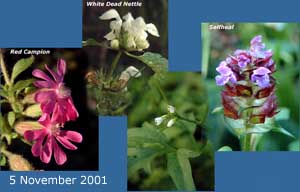
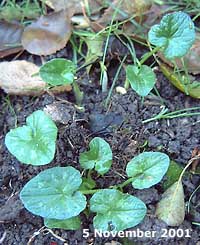
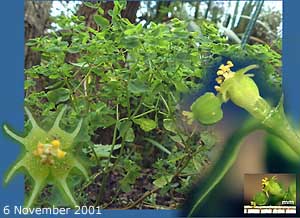
 8
November - The good
weather of last week is now giving way to the first taste of
a British winter. Today a morning with a cold North wind saw
a short period of very strong winds which bent the Birch tree
over even further than shown in the picture. The skies turned
dark and for a short time snow (or soft hail?) fell - it melted
straight away.
8
November - The good
weather of last week is now giving way to the first taste of
a British winter. Today a morning with a cold North wind saw
a short period of very strong winds which bent the Birch tree
over even further than shown in the picture. The skies turned
dark and for a short time snow (or soft hail?) fell - it melted
straight away.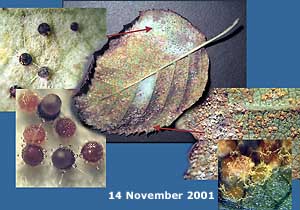
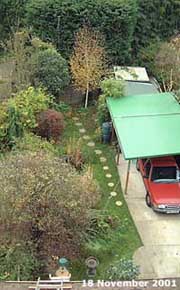

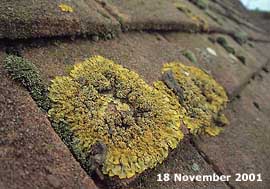
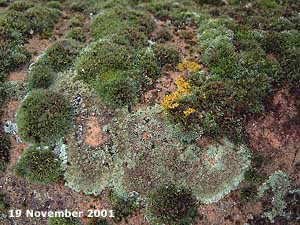 20
November - Yesterday
I spent a bit more time on the roof and here are a few more observations.
20
November - Yesterday
I spent a bit more time on the roof and here are a few more observations.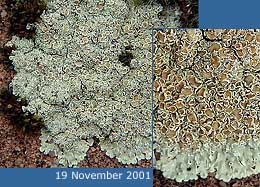
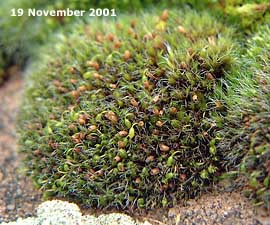
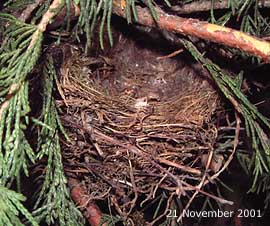 21
November - Most of
today was spent trimming the Leylandii. I came across two similar,
neat nests that I was not previously aware of, about 15 and +20ft
up.
21
November - Most of
today was spent trimming the Leylandii. I came across two similar,
neat nests that I was not previously aware of, about 15 and +20ft
up.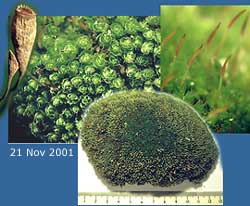
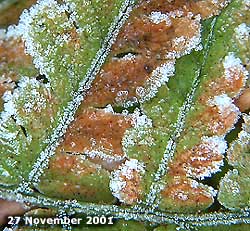 27
November - The first
'hard' frost that I have seen so far this season. I only just
saw it before the sky was rapidly covered by cloud and the temperature
rose. The bird bath water was frozen solid, although the ponds
escaped icing (water temperature 2C).
27
November - The first
'hard' frost that I have seen so far this season. I only just
saw it before the sky was rapidly covered by cloud and the temperature
rose. The bird bath water was frozen solid, although the ponds
escaped icing (water temperature 2C).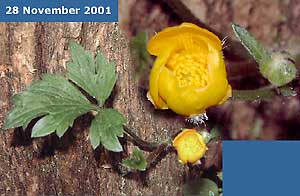 28
November - At the beginning
of the month I mentioned the wild plants that I could see in
flower. Well, they are all still in blossom and today they are
joined by this (I think) Creeping Buttercup (Ranunculus repens).
It will be interesting to see if the second bud opens in the
next couple of days. My wild flower books agree that it should
flower between May - August (September), so it is a bit out of
season!
28
November - At the beginning
of the month I mentioned the wild plants that I could see in
flower. Well, they are all still in blossom and today they are
joined by this (I think) Creeping Buttercup (Ranunculus repens).
It will be interesting to see if the second bud opens in the
next couple of days. My wild flower books agree that it should
flower between May - August (September), so it is a bit out of
season!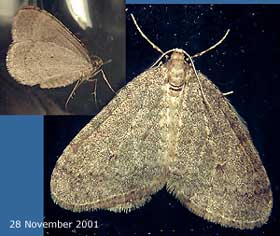 Tonight,
this moth appeared on the kitchen window, the first moth I have
seen for a few weeks. While the main picture shows it with its
wings in the usual moth position (measuring 20mm across), it
also held its wings vertically over its back, butterfly style.
Tonight,
this moth appeared on the kitchen window, the first moth I have
seen for a few weeks. While the main picture shows it with its
wings in the usual moth position (measuring 20mm across), it
also held its wings vertically over its back, butterfly style.